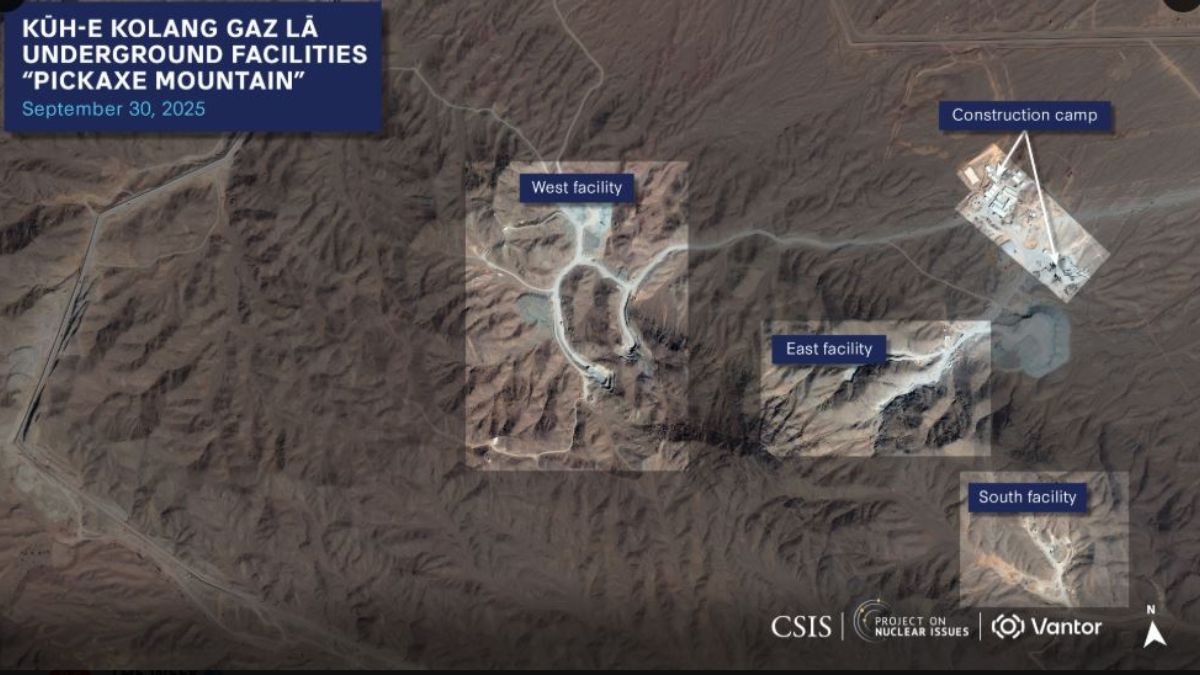Revealed: Iran could be building a secret uranium enrichment centre deep inside Pickaxe Mountain
 Satellite image showing Iran ramping up construction at the secretive Pickaxe Mountain facility | CSIS
Satellite image showing Iran ramping up construction at the secretive Pickaxe Mountain facility | CSIS
Satellite images obtained by the US-based Centre for Strategic and International Studies (CSIS) revealed that discreet construction work was going on at Iran’s underground nuclear facility of Kūh-e Kolang Gaz Lā, also called the Pickaxe Mountain. The facility is located one mile south of the Natanz nuclear site.
According to the CSIS expert assessment, a massive security wall has been erected around the site and its new entrances. The images taken between June 30 and September 30 show that Iranian authorities have intensified construction activities in the Pickaxe Mountain.
Huge piles of dirt and sand are visible at the Eastern and Western entrances of the facility so as to conceal activities and reduce satellite detection, according to a report published by Iran International.
The analysts at CSIS believe that the increased engineering activity at the site following the recent US and Israeli strikes indicates Iran's efforts to move parts of its nuclear programme deeper underground to protect it from future attacks. Earlier, there was satellite imagery that showed Iran’s deep nuclear military facility beneath the mountain.
According to recent imagery, the previously closed southern tunnel remains inactive, while the activity is concentrated in the eastern and western sections of the complex.
Multiple possibilities
The CSIS analysts believe there could be three scenarios for the project’s purpose. Iran could be completing the centrifuge assembly hall it promised to build inside the mountain after the 2020 Natanz fire. It could have also moved the damaged enrichment and metallurgy activities at the Isfahan facility, including uranium hexafluoride (UF₆) gas production.
The third, and most dangerous, possibility is that Pickaxe Mountain could have become a secret uranium enrichment center, which could be used to increase enrichment from the current 60 percent to 90 percent, which would enable it to produce nuclear weapons.
The report emphasised that these hypotheses have not yet been conclusively proven, but the depth of the underground site, the breadth of its entrances, and the acceleration of work there after the attacks are clear indications of Iran's rapid efforts to rebuild its sensitive nuclear capabilities. The center added that this facility could mark a new phase in the development of Iran's nuclear infrastructure, noting that its deep rocky foundation and multiple entrances could make it virtually immune to any future airstrikes.
Burying the inlets under layers of soil also helps regulate internal temperature and prevent the emission of heat signals, a technique commonly used in highly advanced enrichment facilities.
Despite the destruction of the Fordow, Natanz, and Isfahan facilities in airstrikes last June, experts believe that Iran has succeeded in moving part of its nuclear program underground in just three months, demonstrating that its technical and engineering capabilities for reconstruction remain strong and effective.
Middle East